Here’s part 2 of my Tecnifibre Triax String Review. I have now tested the string for a month in a couple of different racquets.
If you want to read my first impressions post about the new Tecnifibre Triax string, click here. For you who haven’t heard about Triax, it is a string that is 50% poly and 50% multifilament. The idea is to provide good comfort for hard-hitting players who usually use poly strings. It’s a well-known problem among tennis players that stiff racquets and stiff strings can create arm issues like tennis elbow or wrist tendonitis. The Tecnifibre Triax string is supposed to be comfortable, but still durable and spin-friendly. Does it do what it says on the label?
Yes, I think in this case, the hype seems to add up. This is one of my favorite multifilament strings on the market, perhaps in part because it comes in a 1.38 gauge. The thicker the gauge, the better the durability and control (and the stiffer the string). I prefer multis at around 1.30, but that Triax comes in 1.25, 1.28, 1.33, and 1.38 gauge is a big plus. I felt like I got good control, nice feel, and no string movement (similar to poly strings). The only slight downside compared to my regular polys is that I didn’t get quite the same bite on the ball. But the feel was different and in many ways better than polys.
How does it play? Video review live at 7:30 pm CET
I tried Tecnifibre Triax in four different racquets.
- Customized Babolat Soft Drive Original at 55 lbs.
- HEAD Pro Tour 2.0 at 53 lbs.
- Wilson K-Factor Six One 95 in a hybrid setup with Triax in the mains at 56 lbs and HEAD Hawk Touch in the crosses at 54 lbs.
- Wilson Pro Staff Tour 90 in a hybrid setup with the Triax in the crosses at 55 lbs and Mayami Tour Hex in the mains at 53 lbs.
It performed well and held tension well in all these setups. It lasted around 8 hours in the Soft Drive, which is known to be quite a string breaker and it has held tension well without any fraying for hours in all the other racquets. So I found this 1.38 gauge Triax to perform well in both full beds and hybrids. It will not last as long in an open pattern, 100 sq inch racquet like the Soft Drive, but 8 hours is better than most polys I use (they might not break but drop tension quickly).
I found the tension maintenance to be really good with Tecnifibre Triax. I take frequent measurements using my ERT 300 tension computer and after settling from the stringing machine, it didn’t drop much at all.
Simply, a very enjoyable string. Let’s look at some pros and cons of Tecnifibre Triax.
Pros and Cons
+ Durable – Not as spin-friendly as a poly
+ Comfortable – A bit pricey
+ Controlled – String breakers will still break it fast
If you are a poly lover and a string breaker, this might not be spinny or durable enough for you. But if like softer polys or just want more control from your multifilament setup, Triax is definitely a string to try. Too many club players use polyesters when they don’t really need to, risking their arm health. My recommendation is to try a high-quality multifilament string and see if that works for you.
Summary
Tecnifibre Triax is one of my favorite (if not the favorite) multifilament string on the market. I like softer polys and this one comes close to that in feel, but still retains that more comfortable feel of a multifilament string.
Have you tried Triax yet? Thoughts?
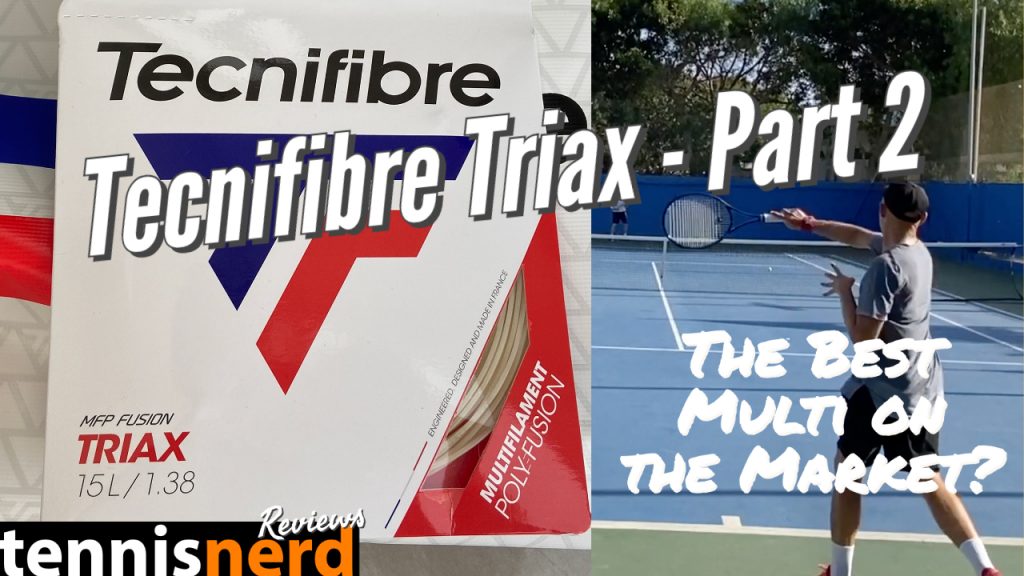
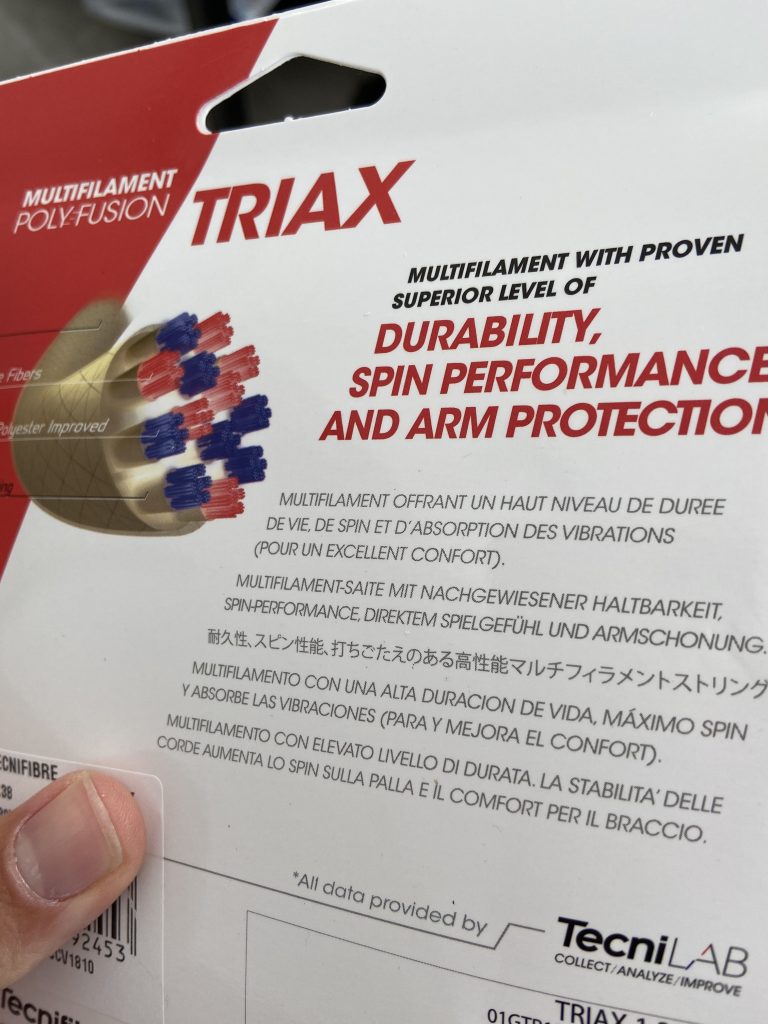
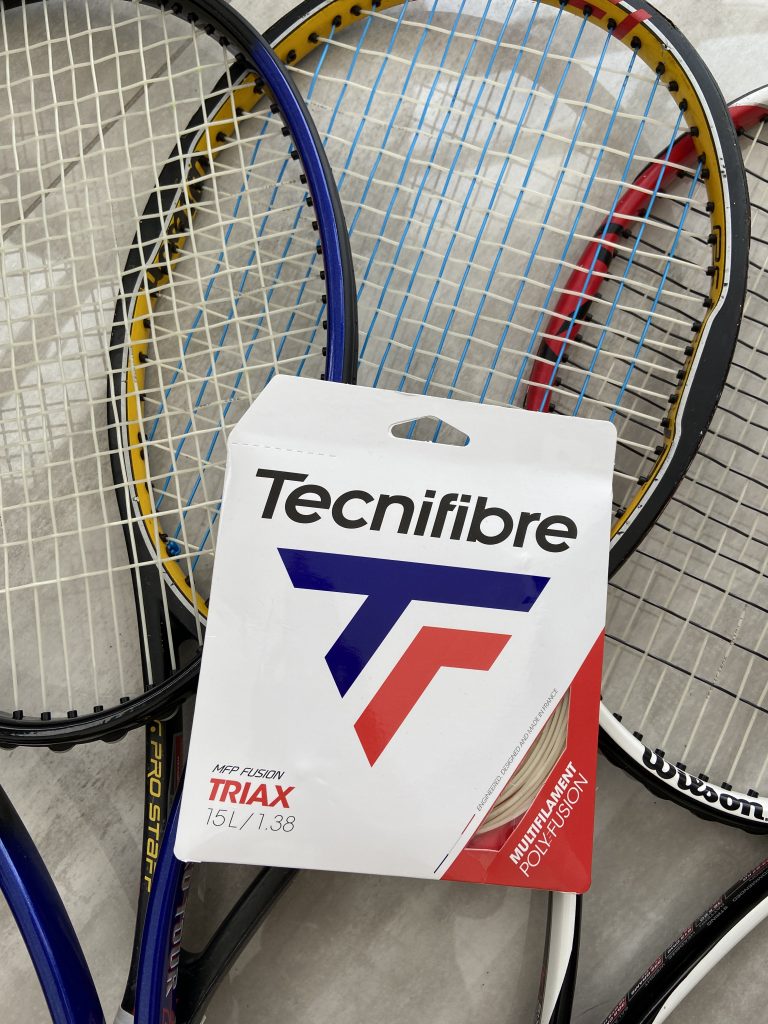
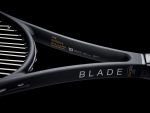







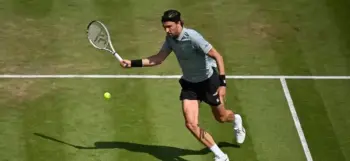
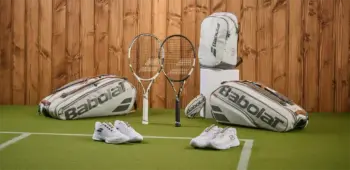





I play with Gamma live wire professionnal lately in the mains with wilson revolve in the crosses. I find Live wire much better than Head velocity mlt. I’ll give the triax a try when I’ll run out of Live wire.
Sounds interesting. As it is described as 50% multi / 50% poly, and you are trying the 38-guage mainly (at the control end of the range), how about trialling a hybrid with a multi as well? I imagine Triax in the mains and Biphase in the crosses could be a very interesting combo of control and power.
I’m curious about putting Triax in the crosses with a shaped string like the Tour Hex in the mains.
Was the Tour Hex able to slide sideways and snap back to enhance spin (or did the Tour Hex dig into the Triax and stop that)?
Did you have to reposition the Tour Hex a lot?
Did the edges of the Tour Hex chew up the softer Triax, shortening its life?
Hi ! Could you compare the triax to the Velocity in terms of spin and tnsion maintenance ?
Thx
Both spin and tension maintenance are better with Triax – that is closer to a poly-style string, so also a bit stiffer.
My 11 year old daughter liked Triax however it started to shred after 3 hours of play.
I think I will try this string. What tension do you recommend? I tend to use Volkl Cyclone (1.25) at 24 kg on my racquet (100 sq in). Would you string the Triax at same tension or would you add 1 kg or so to get the same control?
You never mentioned if you preferred it in a hybrid setup or FB? And did you try it in hybrid with Triax in the mains as well?
Yes, and I enjoyed it, but I would generally prefer a slightly softer multi (or gut!) in the mains.
Amazing string as a hybrid setup best I’ve tried and good alternative to gut on those wet days, however this string snaps easily if you are a big hitter so have a spare racquet ready. Go for gut in hybrid anyday over this.
I’m a senior player and I use a Tecnifibre 300 XTC and have been using 17gauge NXT Comfort for elbow protection. Wanted to find something that would put a little more pop on the ball without being too tough on the elbow; so I thought I would try Triax 17g. instead of a soft Poly or a Hybrid setup. I usually string the NXT at 53/54lbs. What tension would you recommend stringing the Triax, so that it would be easy on the elbow?
Thanks, George
I tried this at 1.28mm, 54lbs in a full bed, after mainly playing alu power rough at the same tension, as my arm was getting sore during matches (to the extent it would affect the way I chose to hit the ball). Play 3-4x a week and hit aggressive with spin (but dont tend to break strings too much).
Really love the string. Feels so much more comfortable and eliminated arm pain. Gives away some control and spin – but not much, and the way I see it, surely an ability to play more frequently and hit with confidence and pace (especially in a second or third set when arm tiredness sets in) outweights marginal benefits from the string.
Other factor is tension maintenance – currently played for 10 hours and has only dropped to 52lbs. Thats much better than the Alu power performs – I think it helps again with shot confidence as youre more likely to get a similar feel from the string over . Strings dont seem to move any more than the poly; they give a little more if you try and move the strings with your fingers but not noticeable when playing at all.
String frayed a little early on (2 hours) but hasn’t broken yet after 10 hours and still plays as it did at the start – will see how long it carries on for. Maybe I just got lucky it lasted this long and would definitely recommend carrying a spare as I could see this breaking more frequently than the Alu power. However, after playing for c. 10 hours the alu power tends to get a little uncontrollable anyway (usually loses about 10lbs tension over that time) and I would have to cut the string out – so dont see much difference here for me in terms of how often I would need to restring.
Will probably try the gauge up next time to see how much spin and comfort drops, and how much durability goes up.
Overall, will be playing with this more while experimenting with other things.
It breaks very fast. I put it 2 times already on my 10 yrs old son’s ezone racquet and he just broke it in 3-4 weeks ? (he is not a big hitter and he did never break a string). I used it in hybrid with polytour pro in the cross.
You big hitters with semi-Western grips and massive topspin will ALWAYS break strings. 15 gauge Kevlar? You’ll break it. Try using an Eastern grip, maybe even slice-drive a few on purpose, not just when run wide to your forehand side. Too much semi-Western = lots of business for racquet stringers etc. I use an Eastern grip forehand, pretty flat, and a set of 17 ga. GUT lasts me 8 or 9 months before cutting through itself.